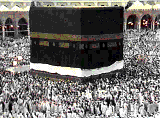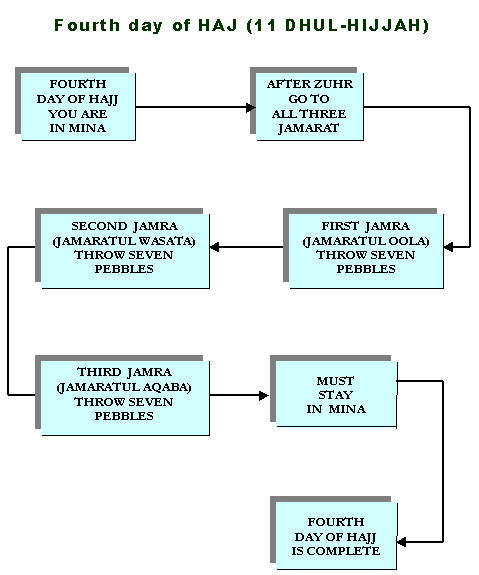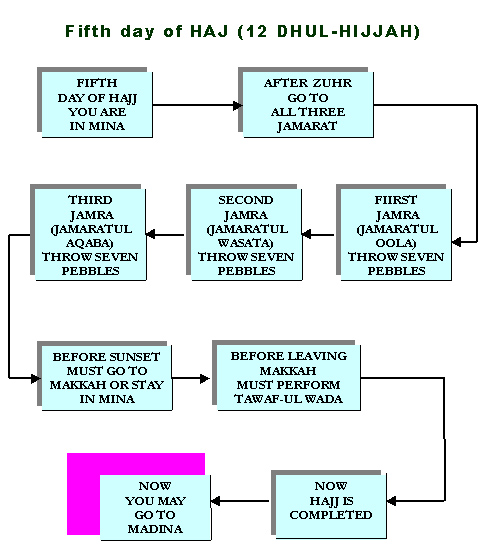HAJJ UMRAH
Calling All Muslims in the World!
If you can afford expenses Don't miss this Golden Opportunity of performing
which is most commendable & equal to Hajj in merit & excellence

Hajj 2011-1432h
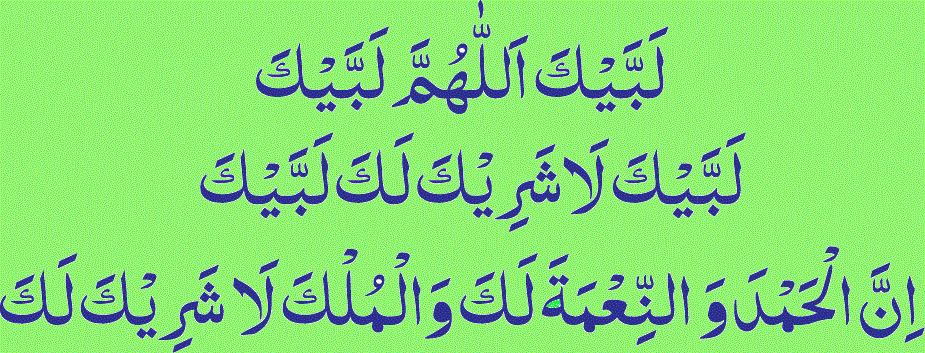 |
|||
|
Here I am at Thy service O Lord, here I am. Here I am at Thy service and Thou hast no partners. Thine alone is All Praise and All Bounty, and Thine alone is The Sovereignty. Thou hast no partners. |
|
Haj Schedule - Day First
|
||||||||||||
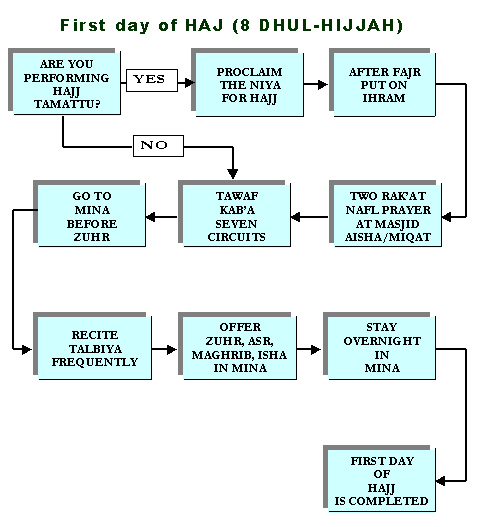
|
Hajj, a pilgrimage to Makkah, is an once-in-a-lifetime obligation for those Muslims who have the physical and financial ability to undertake the journey. Hajj activities take place during six days (8th-13th) of the Islamic Lunar month, Dhul-Hijjah.
Umrah is another pilgrimage to Makkah that can be undertaken at any time of the year. It is sometimes called as the 'minor pilgrimage' (Hajj being the 'major' pilgrimage). Though Umrah is not compulsory but is highly recommended, so says the Islamic tradition.
As a government-recognized company, Faisal tours & travels Tours and Travels is one of the leading companies in the World, predominantly operating in Hospitality management with its unbeatable 20 years of experience in rendering Hajj & Umrah services. Our expanding and constantly improving network of hotels in Makkah, Madinah and Jeddah coupled with excellent services and competitive prices, places Faisal tours & travels miles ahead of all competitors.
We offer elaborate infrastructure, own accommodation, hygienic food and comfortable travel arrangements within Saudi Arabia at various budget levels.
Within a short span of time, Faisal tours & travels has successfully established itself to be a pioneer in Hajj & Umrah Service through its unparallel standards in quality of service and hospitality. We have the maximum number of Hajj quota licenses from the ministry of external affairs, Govt. of India, thus having the pleasure of serving the maximum number of pilgrims every year.
We consider it our duty to ensure that each and every pilgrim experiences a comfortable, hassle free and safe Hajj or Umrah journey. We strive to remain fair and honest in all our dealings, delivering what we promise. You are greeted as a friend and treated as very special visitor, assuring you the utmost comforts while you perform your spiritual duties to the Creator in peace and comfort.
What we do:
Tailor made packages on request
- Pre Departure seminars & Guidance
- Airport services receiving and assistance.
- Guide for performing all the rituals
- Medical Assistance.
- Providing 24 hours (telephonic) assistance.
- Comfortable accommodation in Mina, Arafat & Madinah.
- Individual assistance (wheel chair, ambulance etc) available on request
All adults can participate, ladies must be accompanied by Mehram as per sharia requirement
Persons who are aged, handicapped, who need regular escorts must be accompanied by their own family members.
Persons not feeling well/fit or sever heart ailment, hypertension or any intolerable physical problem must be accompanied by their relatives / guardians / escorts.
Ladies in any stage of pregnancy cannot participate
We reserve the right to cancel or reject any application.
Fare charges Does not include:
Qurbani
Passport Service
Medical
Personal Purchase
Extra Baggages & Coolies
Our package includes return Airfare, Hajj visa, stay through out the period of Hajj, fees of the Moallim in MAKKAH MOUAZZAMA & MADINA MUNAWARRAH transportation during Hajj, food & ziyarat of Holy places in Makkah Mouazzama and Madina Munawwarah.


|
It has the same rites as regular Umrah only more rewarding |
Click here for detalied information

What is Umrah? Umrah is a mini Hajj that can be performed at any time of the year. It can be performed along with Hajj and in other days as well. According to Quran:
"---accomplish Hajj and Umrah to please Allah". (Al-Baqrah, 196)Great Merits of Performing Umrah
The Holy Prophet (peace be upon him) has described the great merits of performing Umrah.
He has said:"The people who come to perform Hajj or Umrah are the guests of Allah because they visit His House on His Call; therefore, Allah grants them what they ask for".1He has also said:"One Umrah becomes an atonement for the sins committed up to the next Umrah".2He has said again:"Anyone who leaves his house with the intention of performing Hajj or Umrah and dies on the way will enter paradise without judgement. Allah is proud of those who perform tawaf of Baitullah".3Umrah in Ramadan
Performing Umrah during Ramadan is most commendable and equal to Hajj in merit and excellence.4Clarification: It is quite true that an Umrah in Ramadan equals a Hajj and one can get the same rewards that are granted to one who performs a Hajj. But this act does not substitute the performance of Hajj which is Fard (imperative), once in a life time if one is financially and physically capable.
RULES FOR UMRAH
In Umrah, pilgrims do not go to Mina, Arafat and Muzdalifa or throw pebbles on the Jamrahs (stone pillars representing devils) or offer animal sacrifice. These rites are performed during Hajj.
- Umrah is Sunnat Mu'akidah: Umrah is neither imperative (Fard) nor obligatory (wajib), but performing Umrah once in a life time is Sunnat Mu'akidah. However, once or more than once, whenever it is performed, it fetches great rewards.
- No Fixed Time: There is no fixed month, day or time for Umrah as it is for Hajj. As said earlier, it can be performed any time one desires.
- The Miqat for Umarh: The station of Ihram (Miqat) for Umrah is Hill for the residents of the Haram of Mecca and the people of Hill. As mentioned later, the area between the five appointed Miqats of Hajj and the bounds of the Haram of Mecca is called Hill. The Afaqis (outsiders) who come to Mecca for Hajj and Umrah should already be in Ihram before entering into Mecca. However, for subsequent Umrahs, even they have to go to Hill to put on Ihram. For this purpose, buses outside Bab Abdul Aziz of al-Haram take pilgrims to Masjid Aai'sha which is in Hill on Madinah Road at Tan'eem, not far from Mecca.
- The Rites of Umrah: The only rites of Umrah are:
- Entering the state of Ihram
- Tawaf of Ka'bah
- Sa'yee between the hills of Safa and Marwah
- Shaving or clipping of the hair
1 Albraz 2 Bukhari, Muslim 3 Albehiqi 4 Abu Da'ud, Bukhari
HOW TO PERFORM UMRAH
IHRAM FOR UMRAH AND ENTERING MASJID AL-HARAAM
- Ihram: You should be already in Ihram for Umrah before entering Mecca or as mentioned earlier, enter the state of Ihram at Masjid Ai'sha in Hill if it is your subsequent Umrah or if you are the resident of the Haram of Mecca or of Hill. If you are entering into Ihram now, the next step is to cover your head and offer two rak'ahs of nafl. Then uncover your head, intend to perform Umrah and proclaim Talbiyah three times and as often afterwards as possible. This starts all the restrictions of Ihram which are listed in the description of Hajj. You may review the complete procedure to enter into Ihram discussed earlier.
- Entering Masjid al-Haraam: While reciting Talbiyah, enter Masjid al-Haraam preferably through Bab
as-Salam with right foot first. Supplicate to Allah and proceed towards Ka'bah. You may recite the following supplication which is usually used before entering a mosque: Allah huma aftah li abwabe rahmate ka
- First Sight: At the first sight of Ka'bah, keep your eyes fixed at Baitullah and standing at one side, it is suggested that you do the following:
- Say Allahu Akbar three times
- Say La Ilaha Illallah three times
- Proclaim Darud on our beloved Prophet (peace be upon him) and very humbly and with tears in your eyes supplicate to Allah for whatever you wish. This is a special time for the acceptance of prayers.
The idea is to praise and glorify your Creator before proclaiming Darud and supplications. Therefore, in lieu of Allahu Akbar and La Ilaha Illallah, you may recite some other similar holy verses if you so desire.
- After this, while uttering Talbiyah, move forward to perform Tawaf of Ka'bah.
TAWAF OF UMRAH
Tawaf means circling around something . Here it means moving around Ka'bah seven times with extreme love and devotion.
- Preparation: Pass the upper sheet of Ihram from underneath the right arm and put it on the left shoulder. This act bares the right shoulder and is known as Iztaba. Ablutions (vudu) is essential for tawaf. Reciting of Talbiyah is stopped when you reach Hajar-e-Aswad, the starting point of tawaf.
- Niyyah (Intention): Stand in front of Ka'bah facing Hajar-e-Aswad (the Black Stone) in such a way that the whole Hajre-e-Aswad is on your right side. To achieve this end, you may get help from the black stripe on the floor. This stripe should be on your right side. Then without raising your hands make Niyyah (intention) for Umrah:
" O Allah, I perform Tawaf of Umrah to please You. Make it easy for me and accept it from me."- Istilam: Now moving towards right, come in front of Hajar-e-Aswad and kiss it if possible, or touch it with a stick and kiss the stick; if that also is not possible, raise your hands to your ears keeping your open
palms towards Hajre-e-Aswad and say: " Bismillahi Allahu Akbar Wa Lilla Hil Hamd"and drop your hands down. Now point the palms of your hands again towards Hajar-e-Aswad and kiss them. This act of kissing Hajar-e-Aswad or pointing towards it is called Istilam.
- Tawaf Starts: After Istilam, turn right and start tawaf counter clockwise.
WARNING
- The authorities often apply perfume to Hajar-e-Aswad, Rukn Yamani and Multazam. If so, do not touch them while in the state of Ihram, otherwise a dum will be required as a penalty.
- During tawaf, it is not permissible to face or turn your back towards Ka'bah except when you are kissing or pointing towards Hajar-e-Aswad.
- Ramal: For the first three circuits of Tawaf of Umrah and Tawaf of Arrival, men are required to move their shoulders and walk with quick short steps. This act is called Ramal and is Sunnah. They walk normally during the remaining four circuits.
- Supplications of Tawaf: There are no fixed supplications for tawaf but there are several recommended supplications listed in the books of Hajj and Umrah out of which the following supplication is easy to memorize:
"Subhan-Allah wal-hamdu-lillahi wa la ilaha ill-Allah wa-Allahu Akbar wa la haula wa la quwwata illa-billah."If you don't remember these words, you may glorify Allah by repeatedly uttering:Subhan Allah, Al-Hamdu lilla, Allahu Akbar, La Ilaha Illallah, etc.The Prophet of Islam (peace be upon him) has said that there are two kalimahs that are light on tongue and (on the day of judgment) they weigh heavy on the scale (Mizan) and are liked by Allah. These kalimahs are:Subhan Allah Wabe Hamde hi Subhan Allah Hil Azeem (Bukhari, Muslim, Tirmizi)You may also use supplications used in the daily Salah or you may seek forgiveness of Allah and ask Him whatever you wish in your own language.
- Hatim: Hatim is a semi-circular half-built portion which was originally a part of the Ka'bah but which could not be included in the main structure when the Ka'bah was rebuilt. It is obligatory to go around Hatim also while performing tawaf.
- Rukn Yamani and its Supplications: After passing the three corners of the Ka'bah you reach the fourth corner known as Rukn Yamani. Touch it with both hands or with right hand. There is a beautiful supplication to be used while walking between Rukn Yamani and Hajar-e-Aswad:
"Rabbana atina fid-dunya hasanatan wa fil-akhirati hasanatan wa qina azabin-nar."Our beloved Prophet (peace be upon him) has repeatedly recited this supplication. The first circuit is complete when you reach Hajar-e-Aswad.
- Seven Circuits: At Hajar-e-Aswad, start the second circuit by kissing it or pointing towards it as you started the first circuit, i.e., come in front of Hajar-e-Aswad, raise both hands to your ears with open palms towards it and say:
" Bismillahi Allahu Akbar Wa Lillah Hil Hamd"Now kiss both palms and drop your hands. After this go around Ka'bah as you did before and similarly complete the seven circuits.
- The End of Tawaf: At the end of seven circuits, do Istilam of Hajar-e- Aswad or point towards it eighth time which is Sunnat Mu'akidah. Also say:
"Bismillahi Allahu Akbar Wa Lillah Hill Hamd"- Iztaba Finished : Now Iztaba is finished, therefore, you cover your both shoulders with upper portion of the Ihram sheet. This does not apply to women.
- Multazam: Now, come to Multazam which is a place five or six feet in length between Hajar-e-Aswad and the door of Ka'bah. This is a highly sacred place where prayers are accepted. Among a large crowd of people, if it is possible to reach Multazam, cling to it pressing your chest and cheeks, and while trembling and crying with devotion and with all humility seek Allah's mercy, His blessings and ask Him whatever you wish. If you are unable to come close to Multazam, just face towards it and supplicate from a distance.
- Maqam Ibrahim: Next offer two rakahs of nafls behind and close to Maqam Ibrahim without covering
your head. If it is zawal time when sajdah is not allowed, you have to wait till this undesirable time is passed and then offer prayers. In the niyyah (intention), say that you are offering 2 rakahs of nafls wajib al- tawaf. Recite Qul ya ayya hal kafroon in the first rakah and Qulhu wallah in the second rakah. After this, supplicate to Allah in Arabic or in your own language. Ask Him whatever you wish and invoke His blessings.
If it is not possible to offer this obligatory prayer near Maqam Ibrahim, it can be offered anywhere in Mataf, or in Hatim or anywhere in Masjid al-Haraam or even at any place in Haram of Makkah.
- Zamzam: Now go to Zamzam well situated in the basement of the Haram about 200 feet from the Ka'bah's door. There are separate portions for men and women. Zamzam is the best available water in the world. Drink this water to fill while in standing position saying Bismillah. Then supplicate to Allah:
"Allahummah inni as'aluka ilm-an naafi'an wa rizqan waasi'an wa shifa'am min kulli daa'in."
(O Allah! I implore Thee for beneficial knowledge, for vast provisions, and for cure from every disease.)
RULES FOR TAWAF OF UMRAH
- One should be in the state of Ihram before starting Tawaf.
- There are three conditions essential for Tawaf of Umrah and for all other kinds of Tawaf as well, namely:
- To be a Muslim
- Niyyah (intention)
- To perform Tawaf inside Masjid al-Haraam
Without niyyah, Tawaf is not valid. Tawaf can be performed in Mataf or on different floors of Masjid al-Haram or even on its roof.
- While performing Tawaf, one should not look towards Ka'bah. One has to face Ka'bah only when doing Istilam of Hajar-e-Aswad.
- After completing the seven circuits of Tawaf, if someone deliberately starts the eighth circuit, it becomes obligatory (wajib) for him to complete the second Tawaf by doing six more circuits.
- Undesirable times for prayer are not considered undesirable for performing Tawaf.
- If someone has to discontinue Tawaf because of time for prescribed prayer or because a dead body is brought for a funeral prayer or need for fresh ablutions arises, he can later resume Tawaf at the point where he discontinued.
A CHEKLIST FOR OBLIGATORY (WAJIB) PARTS OF TAWAF
Tawaf is finished but here is a checklist to make sure that no obligatory part is missed.
- One should be free from the state of impurity and must have performed vudu (ablutions). The women are not allowed to perform Tawaf during their monthly period and during the impure state after childbirth.
- One should be properly dressed. The Holy Prophet (peace be upon him) has said:
"Nobody should go around the Ka'bah in a naked state." (Bukhari)- To perform Tawaf on foot, performing Tawaf while riding is permissible only when one is unable to do so on foot.
- To start Tawaf from one's right side in the counter clockwise direction.
- To complete seven circuits of Tawaf.
- During Tawaf, to pass Hatim as well which is in fact a part of the Ka'bah.
- To start Tawaf from Hajar-e-Aswad.
- To offer two rakahs of nafls after each Tawaf. It is undesirable (Makrooh) to combine two Tawafs together and not to offer two rakahs of nafls in between.
- As Tawaf of Umrah is performed while in the state of Ihram, one has to observe all the prohibitions associated with this state.
SA'EY
The literal meaning of Sa'ey is to run or to make effort, but as a Hajj and Umrah term, Sa'ey denotes
search of water for her son. Suddenly the fountain of Zamzam oozed miraculously near the feet of Hazrat Ismael. Sa'ey is included in the rites of Hajj and Umrah to commemorate this event of search and struggle.
walking back and forth seven times between the hills of Safa and Marwah which are situated to the south and north of the Ka'bah respectively. Now there are only signs of these hills and the whole route between them is enclosed in a long gallery. Sa'ey has a historical background. Prophet Abraham left his wife Hazrat Hajra and infant son Hazrat Ismael in the wilderness of Makkah at the command of Allah. The mother and son lived for five days on the food and water they had. When the water was completely finished, the mother ran frantically seven times between the hills of Safa and Marwah in
RULES FOR SA'EY
- Sa'ey is obligatory (wajib) after the conclusion of the Tawaf and not before it.
- To be free from impurity is not obligatory (wajib) for Sa'ey, therefore, women during their monthly period can perform Sa'ey although they are not allowed to enter Masjid al-Haraam, offer Salat or perform Tawaf. They can enter the place of Sa'ey from the outside entrance.
But it is a Sunnah to be free from all types of impurity and be in the state of ablutions during Sa'ey.
- Sa'ey has seven trips and all are obligatory (wajib). But according to Maulana Khalil-ur-Rahman of Pakistan, the four trips are Fard and the remaining three are obligatory (wajib). Just remember all seven trips have to be completed.
- It is a Sunnah to start Sa'ey right after Tawaf but it is not obligatory (wajib). Therefore, if Sa'ey is delayed for some reason, there is no penalty.
- It is obligatory (wajib) to start Sa'ey from the hill of Safa and end at Marwah.
- It is obligatory to perform Sa'ey on foot unless somebody has an excuse when it can be performed by riding.
- During the Sa'ey of Umrah, it is obligatory to be in the state of Ihram. One should also be in Ihram for the Sa'ey performed after Tawaf of Arrival (Qudum), but it is a Sunnah to perform the Sa'ey after Tawaf of Visit (Ziyarah) in ordinary clothes.
- Sa'ey is performed only once during Hajj, either after Tawaf of Arrival (Qudum) or Tawaf of Visit (Ziyrah). But it is better to perform Sa'ey after Tawaf of Visit.
- It is a Sunnah to climb the hills of Safa and Marwah and raise hands for supplication, facing the Ka'bah.
- It is undesirable (Makrooh) to do business during Sa'ey, but one can talk if the need arises.
HOW TO PERFORM SA'EY
- Istilam of Hajar-e-Aswad. Before starting Sa'ey, do Istilam of Hajar-e-Aswad again the ninth time or point towards it, saying:
"Bismillahi Allahu Akbar Wa Lillah Hil Hamad."Now Proceed towards Safa. It is a Sunnah to be in the state of ablutions during Sa'ey.
- Start of Sa'ey at Safa. Climb the hill of Safa and make intention (niyyah) for Sa'ey:
" O Allah! I perform Sa'ey between Safa and Marwah to please You. Make it easy for meNow recite:
and accept it from me.""Inn-as-Safa wal-Marwah min Sha'a'irillah."After this climb Safa to the point from where you can see the Ka'bah, then facing the Ka'bah raise your hands in supplication, sayAllahu Akbar three times and recite the following supplication or ask Allah whatever you wish:
(Al-Qur'an 2 : 158)
(Indeed Safa and Marwah are among the Signs of Allah.)"La ilaha ill-Allahu wahdahu la Sharika lahu, lahul-mulku wa lahul-hamdu wa ala kulli shai'in Qadeer."If you don't remember this, you may use the supplication recited earlier during Tawaf:"Bismillahi Allahu Akbar Wa Lillah Hill Hamd"- Proceed towards Marwah. Come down from Safa and move towards Marwah while reciting this supplication:
"Subhan-Allah wal-hamdu-lillahi wa la ilaha ill-Allah wa-Allahu Akbar wa la haula wa la quwwata illa-billa."If you don’t remember this supplication also, recite Subhan Allah, Alhamdu Lillah, Allahu Akbar repeatedly and keep moving. You may also praise Allah and ask for His mercy in your language or use supplications taken from the daily Salah. When you reach two green pillars, men have to run between them but the women should walk with their normal pace.
- At Marwah. When on top of Marwah, praise Allah facing the ka'bah and repeat the same supplications that were recited at Safa. One trip is over, second trip will be on Safa and third trip will be on Marwah.
- End of Sa'ey. In the same way, the seventh trip will end at Marwah. In all trips the men will run between the green pillars but the women will walk in a normal way.
- Two raka'at Nafl. If it is not an undesirable (Makrooh) time, offer two raka'ats of nafl in the al-Haram.
- Shaving or clipping of hair. After Sa'ey, men should get their heads completely shaved or get their hair clipped to the length of the upper third of their finger or a little more. Both shaving and clipping are permissible for men, though shaving is preferable. Women are, however, allowed to have a lock of their hair clipped. They are forbidden to shave their heads.
- Umrah is complete. After cutting the hair, umrah is complete. The restrictions of Ihram are finished. Now wear your everyday clothes and lead a normal life. Be thankful to Allah that He provided the opportunity for performing Umrah and lead rest of your life according to the commands of your Creator.
NAFL TAWAF
You may perform Umrah as often as you want according to the above procedure. And if you want to perform just a nafl Tawaf, follow the same procedure, however, in a nafl Tawaf there is no Ihram, no Ramal, no Iztaba and even no Sa'ey.
Note: 1.
2.
3.For Umrah topics, click at "Umrah Contents" and for Hajj topics click at "Hajj Contents".
Similarly, click at the type of visa desired, "Umrah Visa" or "Hajj Visa".
In other words:
For Umrah: Click at "Umrah Contents" and Chapters 1 to 10.
For Hajj: Click at "Hajj Contents", "Hajj Visa" and Chapters 1 & 3 to 12.
(You are already at Chapter 8).

